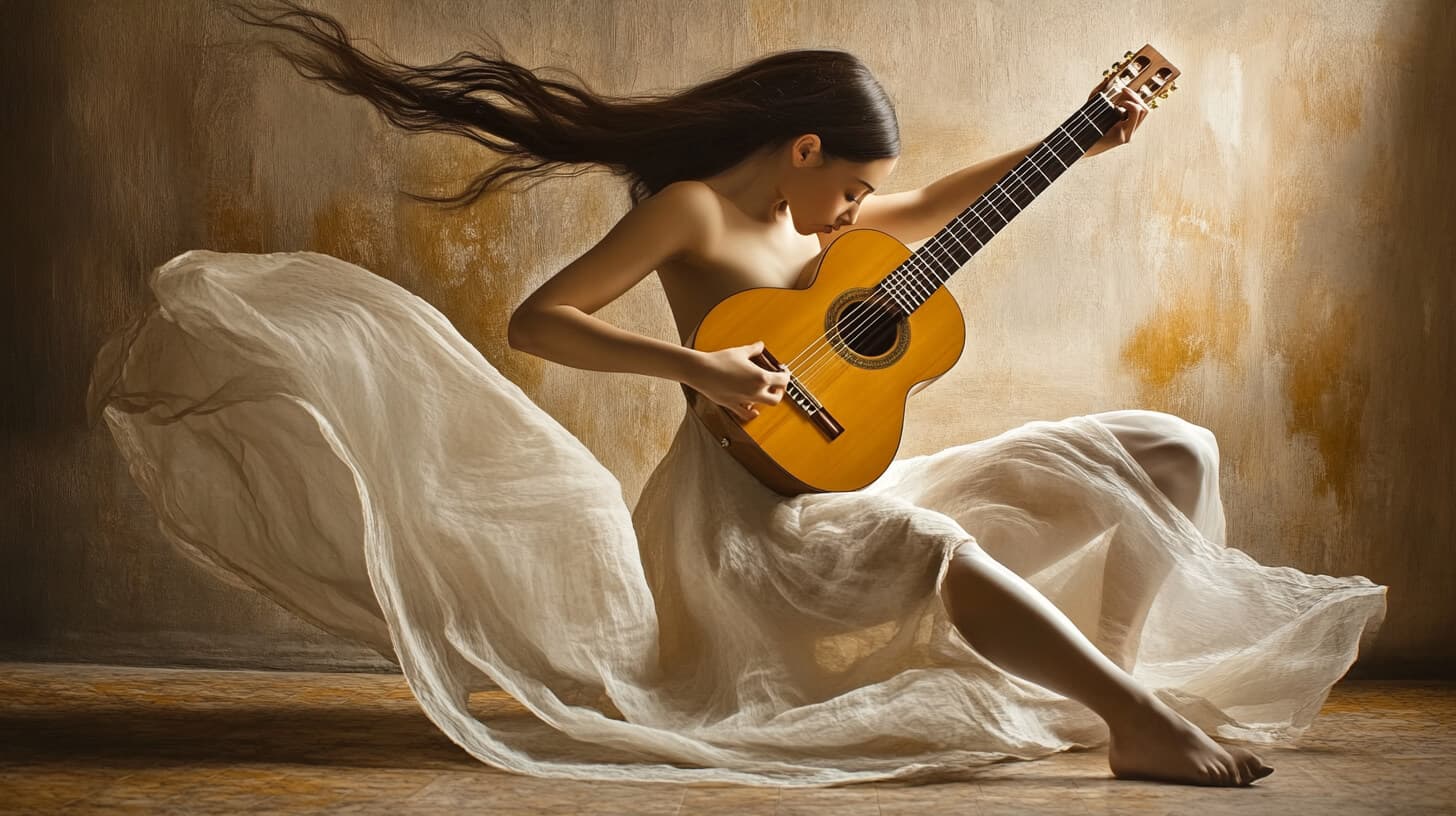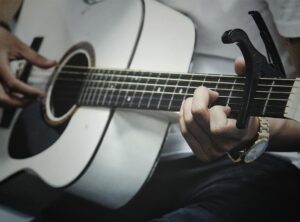Can ballet techniques enhance guitar-playing skills? Absolutely. This article explores how ballet methods can improve posture, finger strength, and rhythm, making guitar performances more expressive and controlled. Additionally, these techniques can make guitar playing more appealing to young people, similar to how The Nutcracker introduces classical music to them.
Key Takeaways
- Ballet techniques enhance a guitarist’s body awareness, improving precision and expressive playing.
- Proper posture is crucial for ballet and guitar; it helps prevent injuries and improves performance quality.
- Incorporating ballet-inspired exercises into guitar practice can boost finger strength, dexterity, and fluid movement, leading to more dynamic performances.
The Connection Between Ballet and Guitar Playing
The dance world and the realm of guitar playing share surprising similarities. Both require a high level of body awareness and precision, traits that are central to ballet and equally beneficial for guitarists. Ballet emphasizes body awareness, which can significantly improve a guitarist’s physicality during performances. This heightened awareness can lead to better control and more expressive playing, allowing musicians to connect more deeply with their instruments.
Furthermore, the discipline of ballet instills a sense of precision and control that can enhance classical guitar techniques. Just as dancers must execute each movement with exacting detail, guitarists can benefit from this meticulous approach, refining their techniques and achieving higher mastery in ballets. When guitarists play for dancers, such as flamenco dancers, they must employ specific techniques and styles to complement and enhance the dance performance, emphasizing musicality and rhythm.
The connection between these two art forms is their commitment to excellence, precision, and expressive performance in classical music.
Posture and Poise: The Foundation of Both Arts
In ballet and guitar playing, posture and poise are foundational elements that significantly influence performance quality. Good posture is not just about looking elegant on stage; it is crucial in preventing musculoskeletal injuries such as back pain and wrist strain. For guitarists, maintaining proper posture helps build muscle memory, making correct techniques more automatic over time.
Moreover, emotions can influence physical posture, affecting a dancer’s movement quality and expression on stage. The same principle applies to guitar playing; a relaxed and confident posture can enhance the performance, allowing for more fluid and expressive strumming. Practicing good posture ensures that dancers and guitarists can perform at their best while minimizing the risk of injury.
Whether you’re performing a complex ballet routine or playing a challenging guitar piece, how you hold your body impacts the overall quality of your performance. By focusing on posture and poise, you lay a rock-solid foundation that supports all other aspects of your art, from technical execution to emotional expression.
Finger Strength and Dexterity
Finger strength and dexterity are critical for guitarists, and interestingly, ballet techniques can be highly effective in developing these skills. Ballet-based exercises can significantly enhance finger strength and coordination, which is essential for proficiency in guitar techniques. These exercises help guitarists develop a stronger connection between their mind and body, leading to more controlled and precise playing.
Incorporating ballet principles into your guitar practice can lead to noticeable play improvements. Exercises targeting finger strength and dexterity facilitate greater control and fluidity, making complex chords and fast-paced melodies more accessible.
Ballet Barre Exercises for Guitarists
Ballet barre exercises can be customized for guitarists, targeting the development of finger strength and enhancing hand control. These exercises can improve grip strength and coordination when playing barre chords on the guitar. For instance, practicing pliés and tendus can enhance the strength and coordination of a guitarist’s fingers and hands, making transitions between chords more fluid.
Integrating ballet barre exercises into your routine builds the endurance for long practice sessions and performances. These exercises strengthen your fingers and improve overall hand control, making it easier to execute complex guitar techniques precisely.
Finger Flexibility Drills
Incorporating warm-up drills from ballet helps guitarists improve their finger flexibility, which is crucial for playing complex melodies and intricate chord shapes. Inspired by ballet warm-ups, these drills can significantly boost finger agility and precision while playing guitar. For example, practicing slow, controlled movements can increase accuracy and fluidity in guitar playing.
Regularly performing these finger flexibility drills improves speed and accuracy in playing. Whether working on open strings or more advanced techniques, these exercises can help you develop the flexibility needed for various musical styles.
Fluid Movements: Translating Dance Flow to Guitar
One of the most captivating aspects of dance is the fluidity of movements, a quality that can greatly enhance guitar playing. Proper posture is essential for optimizing right-hand and arm positioning, facilitating smoother movements across the fretboard. Just as dancers focus on the flow of their movements, guitarists can benefit from this approach, leading to more seamless transitions between chords and notes.
The body’s position can impact the sound quality produced; proper posture allows for better control and cleaner note execution. Focusing on the lower body while keeping the upper body relaxed enhances movement fluidity, mirroring the grace and precision of dancers.
This holistic approach to body positioning can lead to more expressive and dynamic guitar performances.
Rhythm and Timing: Lessons from Ballet
Rhythm and timing are crucial elements in both ballet and guitar playing. In dance, dancers use counts to stay in sync with the music, ensuring their movements align perfectly with the beat. Similarly, guitarists can develop a consistent sense of timing by incorporating rhythm exercises inspired by ballet. Using a metronome during practice can help guitarists maintain a steady tempo, as dancers rely on counts to stay in rhythm.
Incorporating warm-up exercises into your practice can prepare both the mind and body, akin to how dancers prepare before a performance. Integrating these practices enhances overall performance, drawing insight from the discipline of ballet and its choreography. This focus on rhythm and timing can lead to more polished and professional-sounding music.
Expressing Emotion Through Musicality
The dance world and the realm of music are deeply rooted in emotional expression. Dance embodies emotion, with movements as a tool for dancers to communicate their feelings. Similarly, guitarists can express their emotions through dynamics and phrasing in their music. Just as dancers channel emotions through their bodies, guitarists can use techniques like string bending and vibrato to convey their feelings.
Improvisation allows musicians and dancers to express their creativity spontaneously, leading to more authentic and emotionally resonant performances. Being attuned to music and allowing it to guide movements helps performers in both arts create a more natural and flowing performance. This shared emphasis on emotional expression highlights the deep connection between ballet and guitar playing.
Choreographing Your Guitar Practice
Structured practice sessions are essential for both dancers and guitarists. Ballet training promotes mental discipline, translating into focused practice habits for guitarists. Organizing practice sessions with a clear structure can enhance focus and retention, similar to a dance rehearsal’s planned routines. Setting specific goals for each practice session helps maintain direction and purpose, mirroring the objectives set in dance rehearsals.
Combining mental discipline, structured sessions, and goal setting leads to more efficient and enjoyable guitar practice. You can ensure that each session is productive and aligned with your overall musical goals by choreographing your practice sessions.
Classical Guitar in the Dance World
Classical guitar has a rich history of collaboration with the dance world, particularly in ballet. This partnership has produced some of the most enchanting performances, where the classical guitar’s delicate and intimate tones perfectly complement ballet’s grace and precision. One notable example is the arrangement and performance of music from famous ballets like The Nutcracker Suite, which has captivated audiences with its unique and captivating sound.
The classical guitar’s warm and intimate tone makes it ideal for accompanying dance performances. Its ability to convey a wide range of emotions adds depth and sophistication to ballet and contemporary dance. Renowned guitarists such as Andrés Segovia and Christopher Parkening have collaborated with dancers and choreographers to create innovative and expressive works that showcase the versatility of the classical guitar.
The classical guitar is often used in dance to create a sense of elegance and sophistication. Its versatility allows it to be used in various dance styles, from traditional ballet to modern and experimental dance. By incorporating classical guitar into dance performances, choreographers can add a new layer of depth and emotion to their work, enhancing the overall experience for the audience.
Electric Guitar in Contemporary Dance
The electric guitar has become increasingly popular in contemporary dance, particularly in styles such as hip-hop and breakdancing. Its bold and edgy sound makes it ideal for creating high-energy dance performances that captivate audiences. Many contemporary dance companies have incorporated the electric guitar into their scores, using its unique sound to enhance the emotional impact of their choreography.
Influential electric guitarists like Jimi Hendrix and Eric Clapton have left a lasting impression on contemporary dance choreographers, who appreciate the instrument’s expressive and dynamic qualities. The electric guitar is often used to create a sense of tension and release, particularly in pieces that explore themes of rebellion and social justice. Its versatility allows it to be used in various dance styles, from hip-hop to contemporary and experimental dance.
By incorporating electric guitar into dance performances, choreographers can add a new layer of excitement and energy to their work. The instrument’s ability to convey powerful emotions and dynamic shifts makes it valuable for creating impactful and memorable dance pieces.
Collaborating with Dancers
Collaborating with dancers requires a deep understanding of the choreographer’s vision and their needs. Guitarists must be able to listen carefully to the choreographer’s instructions and adapt their playing style accordingly. Effective collaboration requires a strong sense of communication and trust and a willingness to experiment and try new things.
Guitarists can enhance their collaboration with dancers by learning about the choreographer’s process and the dancer’s technique. Attending rehearsals and performances can provide valuable insights into the dance world, helping guitarists develop new skills and strategies to enhance their playing. By working closely with dancers, guitarists can better understand the dance world and expand their artistic horizons.
Collaboration between guitarists and dancers can create innovative and expressive works that push the boundaries of music and dance. By embracing the challenges and opportunities of cooperation, guitarists can develop new ways of playing and creating music, leading to more dynamic songs and impactful performances.
Case Studies: Famous Guitarists Inspired by Dance
Many famous guitarists have influenced their musical expression by incorporating dancing techniques. For instance, Jeff Beck’s playing style incorporates fluid movements akin to dance and utilizes finger techniques for expressive performance.
Recording practice sessions allows musicians to review progress and identify areas for improvement, similar to how dancers critique their performances and watch videos back while listening. These examples highlight how ballet principles can be applied to guitar playing and various instruments, leading to more dynamic and expressive performances that have played a significant role in their development.
Learning from these guitarists allows you to incorporate dance-inspired techniques and dances into your practice, enhancing musicality and performance quality.
Practical Exercises to Integrate Ballet Techniques
Guitarists can improve body awareness and coordination by incorporating ballet-inspired exercises like pliés or tendus during finger warm-ups. Using a barre can help guitarists enhance their finger strength and stability, mimicking the support ballet dancers receive. Daily practice of slow, controlled movements can assist guitarists in achieving the fluidity essential in ballet and guitar playing.
Integrating stretching routines from ballet can enhance flexibility and reduce tension in a guitarist’s hands and wrists. Practicing finger placements as if positioning hands for ballet movements creates a mental connection between the two arts, further improving technique and expression.
The Role of Improvisation in Both Arts
Improvisation can transform structured performances into unique artistic expressions in ballet and guitar playing. Improvisational practice encourages performers to embrace spontaneity, allowing them to create in the moment without fear of making mistakes. This skill enhances the ability to adapt to other performers in real-time, creating dynamic interplay.
Mastering the foundational skills in ballet or guitar is essential before effectively improvising. Successful improvisation often requires a balance between structured practice and spontaneous creativity. Integrating improvisation into practice allows the discovery of unique expressions and styles that might not emerge through structured practice alone.
Summary
In conclusion, the intersection of ballet and guitar playing offers many opportunities to enhance musical performance. Incorporating ballet techniques can improve posture, finger strength, dexterity, fluidity, rhythm, and emotional expression. Drawing parallels between these two disciplines can unlock new dimensions in guitar practice, making performances more dynamic and expressive.
We hope this exploration video of ballet and guitar playing has inspired you to integrate these techniques into your practice. By embracing the elegance and precision of ballet, you can elevate your guitar playing to new heights, creating more impactful and memorable performances.
As we conclude this article, we want to express our sincere thanks to artdeballet.com for their unwavering support and the invaluable resources they provided. Their commitment to excellence and passion for the arts have enriched the content presented here, and we are deeply grateful for their collaboration throughout this journey.


